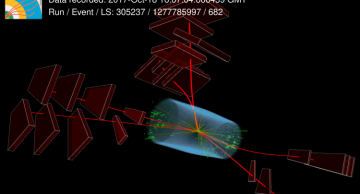As physicists seek the elusive particles that may reveal a new understanding of the universe’s inner workings, one intriguing possibility is the conceivable existence of new particles that live in a shadow universe, called the “dark sector.” The…
News
|
fblekman |
Physics
|
losmith |
Detector
After long months of preparations, the Beam Radiation, Instrumentation, and Luminosity (BRIL) group has completed the installation of three instruments dedicated to the measurement of luminosity and beam conditions: the Beam Condition Monitor “Fast…
|
mazumdar |
Physics
A recent result from CMS searches for long-lived particles through the so-called “Higgs portal” in ways never done before.
For about a decade now the CMS experiment at the CERN LHC has collected and analyzed data from hadron collisions, mainly…
|
fbaldass |
Detector
After more than two years with lots of delicate work the Pixel Tracker has been successfully installed at the centre of the CMS detector and it is now ready for commissioning.
The Pixel Tracker is the CMS sub-detector closest to the interaction…
|
fblekman |
Physics
This year marked the ninth anniversary of the discovery of the Higgs boson; the Standard Model particle linked to the mystery of creating the mass of all the other fundamental particles through the so-called Higgs mechanism. While a single Higgs…
|
fblekman |
Physics
Could you imagine what the dark part of the universe is like?
The Standard Model of Particle Physics explains matter at the subatomic level and the related phenomena such as interactions and forces between the subatomic particles. Still, we…
|
fblekman |
Physics
The interaction of the Higgs boson with its own field leads to its mass generation. Since the Higgs boson mass has already been measured, the study of the Higgs pair production at the LHC reveals directly the strength of the Higgs self coupling λHHH…
|
fblekman |
Physics
High-energy particle accelerators are unique tools to study the structure of matter at the shortest distances. The most powerful accelerator today is the CERN Large Hadron Collider (LHC) that has so far collided beams of protons up to center-of-mass…
|
fblekman |
Physics
For the first time, CMS physicists extract the fundamental parameters of QCD together with constraints on the New Physics.
Any tiny failure of the Standard Model to explain data behaviour is a possible window for the New Physics.…
|
mazumdar |
Physics
The most powerful particle collider in the world, the Large Hadron Collider (LHC), was built in the 27 km tunnel originally excavated for the highest energy electron-positron collider ever built, LEP. As an extraordinarily sensitive machine, LEP was…
|
losmith |
Collaboration
Congratulations to Andrew Gilbert, Marco Luccini and Meng Xiao for winning the CMS Young Researchers Prize for 2021!
The CMS Young Researchers Prize is intended to recognise the outstanding achievements of young members of CMS. It is awarded…
|
losmith |
Collaboration
The awardees of the 2020 CMS Thesis Award are Matteo Defranchis, Cristina Martin Perez and Thorben Quast!
Every year, since 2000, the CMS Thesis Award Committee recognizes and rewards excellence in the CMS PhD student research. Thesis can be written…












